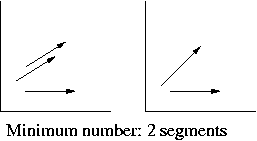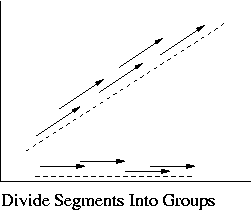A "map" includes a number of segments, specified by the planar coordinates
of their endpoints. We should determine the minimal number of segments
required for drawing this map.

Consider a simplified problem: All segments are on the x-axis:

In the simplified problem, as shown above, we can sort the segments in the
increasing order of their left endpoints and then process them from
left-to-right. We denote the array of left points as left[0...n-1]
and the array of right endpoints as right[0...n-1]. The algorithm for
solving the problem is as follows:
// Precondition: left[0...n-1] is sorted
int simpleSegments (int left[], int right[], int n) {
int counter = 1;
int r = right[0];
for (int i=2; i < n; i++) {
if (left[i] > r)
conter++;
if (right[i] > r)
r = right[i];
}
return counter;
}
Returning to the original problem with two dimensions. If segments in
two dimensions all belong to the same straight line, we can use the
same problem. It is really a 1D problem, with a different baseline
orientation.

So, the big picture solution to the 2D problem is to divide the segments
into groups such that segments in the same group share the same line.
In other words, create one group for each base line and include in each group
all segments oriented along that line. Then, for each group, determine the
minimal number of segments.
For each group we determine the values a and b in the
line equation, y = a*x + b. If two segmetns have the same
a and b, they are along the same line and therefore in
the same group.
If x1 is not equal to x2, then the
line equation is more complex:
y = x* (y2-y1)/(x2-x1)
+
(y1*x2-x1*y2)/
(x2-x1)
In the case above,
a = (y2-y1)/(x2>-x1)
b = (y1*x2-x1*y2)/
(x2-x1)
So, we have the overal algorithm:
- For each segment, determine a and b
- Divide the segments into groups such that segments
are in the same group if they have the same a
and b.
- For each group use the simpleSegments algorithm discused
earlier for the 1D problme to determine the minimal number
of segments
- Add up the resulting minimum number of segments
Implementation issues:
- You should use a hash table or BST for indexing (a,b). In C++
the map or hashmap are good choiuces. In Java TreeMap and
HashMap are good choices
- To avoid minimize rounding errors, always sue double
not float. Or, better yet, don't do the division. Just
keep track of the numbertor and denominator and use cross
multiplication:
a/b == c/d, iff ad == cb
- You should treat vertical lines as a special case, since the
equation y = a*x + b doesn't give us a and b
for these lines.
We consider a list of word pairs in some unknown language and a list of their
translations. The order of translations is not the same as the order of
original word pairs. We need to determine the right translation of each
word.
The right idea is to create the bipartite graphs of possible word matches and
possible pair matches and then to prune these graphs until there is only
one possible match.
For example, we can use the following greedy-search algorithm:
Initialize the search
- Count the number of occurences of each word as the "first word"
- Count the number of occurences of each word as the "second word"
- Create a bipartite "word" graph consistent with the word counts.
- Ensure the "internal consistency" of the word graph by removing
inconsistent edges.
- Create a bipartite "pairs" graph consistent with the "word" graph.
Prune the graph
- Repeat the following until no edges are removed in a pass:
- Ensure the internal consistency of the "pairs" graph by
removing inconsistent edges
- Ensure the "words" graph is consistent with the "pairs" graph by
removing inconsistent edges
- Ensure the internal consistency of the "words" graph by
removing inconsistent edges
- Ensure the "pairs" graph is consistent with the "words" graph by
removing inconsistent edges

The word counts are consistent if the the word on the left side of an
edge and the word on the right side of an edge are used the same number
of times as first words and they are also used the same number of times
as second words. In other words, for every edge (u,v) the counts for
u are the same as the counts for v.
1 0 *----------* 1 0 (good)
1 0 *----------* 2 1 (bad)
A graph is internally consistent if for every edge (u, v), if u
has only one outgoing edge, the v has only one outgoing edge.
*----------* (good)
*----------* (bad)
*_____----/
The "pair" graph is consistent with the "word" graph iff, for every edge
[U1, U2], [V1, V2),
there are edges (U1,V1) and
(U2,V2).
The "word" graph is consistent with the "pair" graph iff the following
are true for every (U,V) in the word graph:
- Every vertex [U*] in the pairs graph has an edge ([U*][V*])
- Every vertex [V*] in the pairs graph has an edge ([U*][V*])
- Every vertex [*U] in the pairs graph has an edge ([*U][*V])
- Every vertex [*V] in the pairs graph has an edge ([*U][*V])
If the Greedy search produces a one-to-one correspondance we are quite
lucky -- this isn't a guarantee. If not, we need to use a recursive search.
- Initialize
- Recursive search
- Prune
- If some vertex in the word graph has no edges, return
- If every vertex has exactly one edge, print out the correspondance
and return -- we win.
- Otherwise, find the vertex with the minimum number of edges and,
for each edge:
- Create copies of the two graphs
- Remove this edge from the graph
- Repeat this recursive search upon the copies
We use several dice, where each die has a certain number of facets with return
values. We need to add a new die, with a given number of values, that ensures
chances of getting certain sums.
For example, consider the following dice: 1,1,1,2 or 1,2,2,2 or 1,1,1,2,2,2.
| Initial Chances |
|---|
| Value |
1 |
2 |
3 |
4 |
5 |
6 |
| Chances |
0 |
0 |
9 |
39 |
39 |
9 |
Now, add a four-sided die to ensure that the chances of getting a 4 is a 5 and
the chance of getting a 9 is a 48. It is important to note that the chances
of getting other sums do not matter. The solution is a die: 1,2,3,3.
This is a messy problem with no neat solution -- at least we don't have one.
The basic approach is to compute the initial chances and to search through
all possible labels of the new die.
To make this problem manageable, we use dynamic programming. We
use recursion and use a table to prevent computing partial solutions
that overlap among one or more paths.
It is important to note that the maximum number of dice is 20 and the maximum
value is 50. As a result, the required table can be no more than 20 * (50*20) =
20,000 entries.
Consider the example:
| Die | Possible values |
| 1 |
3 |
1 |
0 |
0 |
0 |
0 |
| 2 |
0 |
3 |
6 |
3 |
0 |
0 |
| 3 |
0 |
0 |
0 |
39 |
39 |
0 |
The algorithm for initializing procedes as follows:
int chances[0...20, 0...10000] = { {0, ..., 0}, {0, ..., 0} }
chances[0,0] = 1;
int i = 1;
for each dice do {
input the next die, with f facets and values sides[0,..., f-1]
for (k=0; k < f; k++) {
for (j=f[k]+1; k < 1000; k++) {
chances[i,j] = chances[i,j] + chances[i-1, j-f[k]]
}
}
}
From there, we try all possible lables and prune unacceptable combinations.
In the worst case, search through 506* 1010
combinations. It is very slow in theory, but smart pruning can make it work
in practice.
for (each possible value of face1) do {
if (no inconcsistency) {
for (each possible value of face2) do {
for (each possible value of face3) do {
. . .
}
}
}
}
An inconsistency occurss if the chance for a given sum is strictly greater
than the given chance. For example:
| Initial Chances |
|---|
| 1 |
2 |
3 |
4 |
5 |
6 |
| 0 |
0 |
9 |
39 |
39 |
9 |
| Required Chances |
|---|
| 7 |
8 |
9 |
| 9 |
1 |
1 |
In the above example, the possible values for face1 are:
- 1- OK
- 2 - Chances for 8 are too great, prune
- 2 - Chances for 8 are too great, prune
- ...
When setting some value for a facet, make the respective update in the table
of chances. If some chance value becomes too large, then consistency is
violated and we can skip the inner loops.
There are a few ways to optimize this process:
- When updating the table of chances for the new dice, consider
only the sum (columns) of interest.
- Consider only useful values of faces. A value is useful if it is
no larger than the "maximium sum of interest" - the "minimum sum
of initial chances". In other words, don't consider it if it
is to large to be useful.
The implementtion can use recursion in place of nested loops, but this
will run a bit more slowly. In some cases, it is more difficult to represent
the solution using nested loops -- i whcih case the recursion might be
more appropriate.



